Here are the most common genres of election campaign event, in ascending order from least to most valuable: photo op, speech, press conference, interview, and finally interactions with unvetted members of the public.
Guess which one was conspicuously missing from Anthony Albanese’s first week on the trail?
When I refer to value here, I’m talking about how much we can learn about the candidate and their policy platform.
Here’s one example of a photo op, from the Prime Minister’s travels this week. On Monday he visited the maternity ward of a hospital in Perth, where met a mother, Harsimranjeet Sidhu, and her newborn baby Amber, who was just 27-hours-old.
The photos were undeniably adorable.
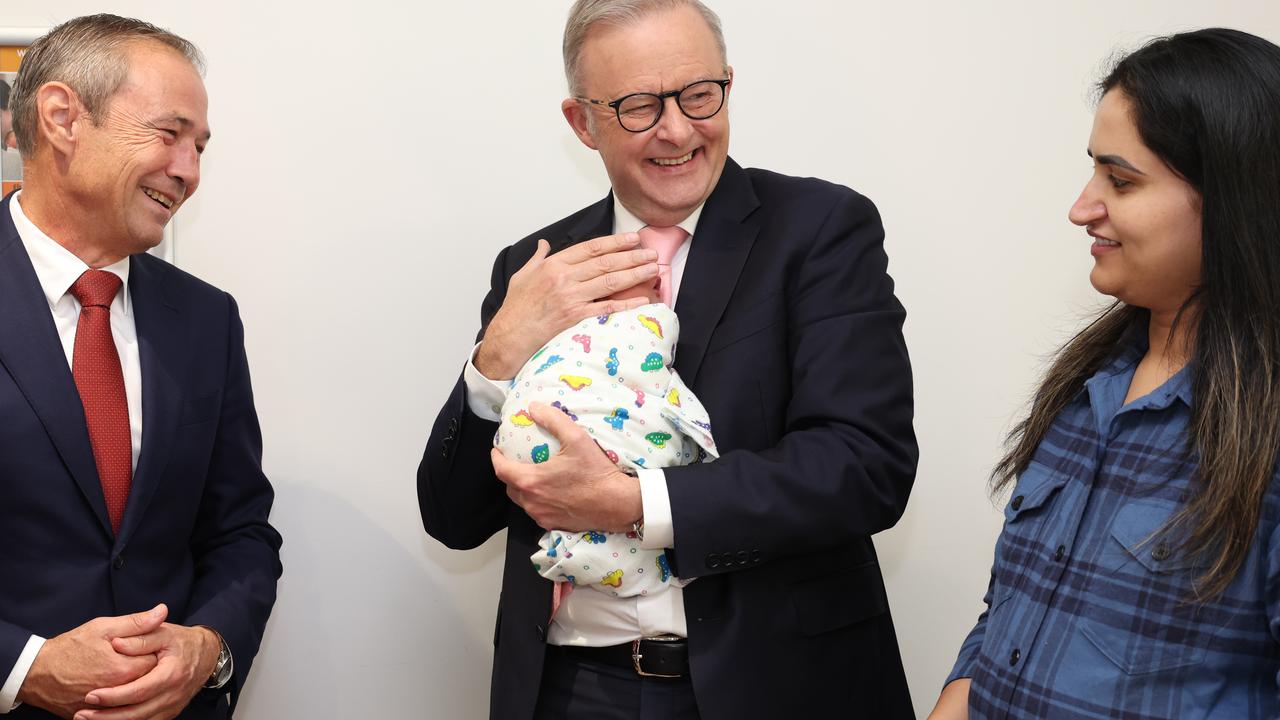
WA Premier Roger Cook was also there, as something of a fourth wheel. That’s not an insult, I relate, it could be me at any social occasion. Picture: Jason Edwards/NewsWire
I probably need not tell you this, but even so, Mr Albanese was aware he would be meeting Ms Sidhu – specifically her – before he got to the hospital. Labor’s advance team had found a mum with a newborn bub who was happy to chat to the Prime Minister. So there was no risk of hostility.
And no risk, really, of the photo op leading to anything probative. All upside, no downside.
Mr Albanese combined that hospital visit with a press conference, as is the norm on these campaigns. There’s a cadence common to all of them: a photo op is lined up to reinforce the day’s announcement (in this case, a couple hundred mil to upgrade the hospital in question), then the candidate pops up for a press conference with the local premier, or perhaps a few of the party’s less hateable frontbenchers, and they all deliver a little preamble on the announcement before taking questions.
(I say little. I could swear the preambles are getting longer and longer. Mark Butler might benefit from an accompanying orchestra to play him off after a strict three minutes.)
Most days involve a single full-scale press conference, and maybe one or two additional doorstops, where there are fewer questions asked. And these are the vehicle through which the media pack following the candidate gets to place them under some level of scrutiny.
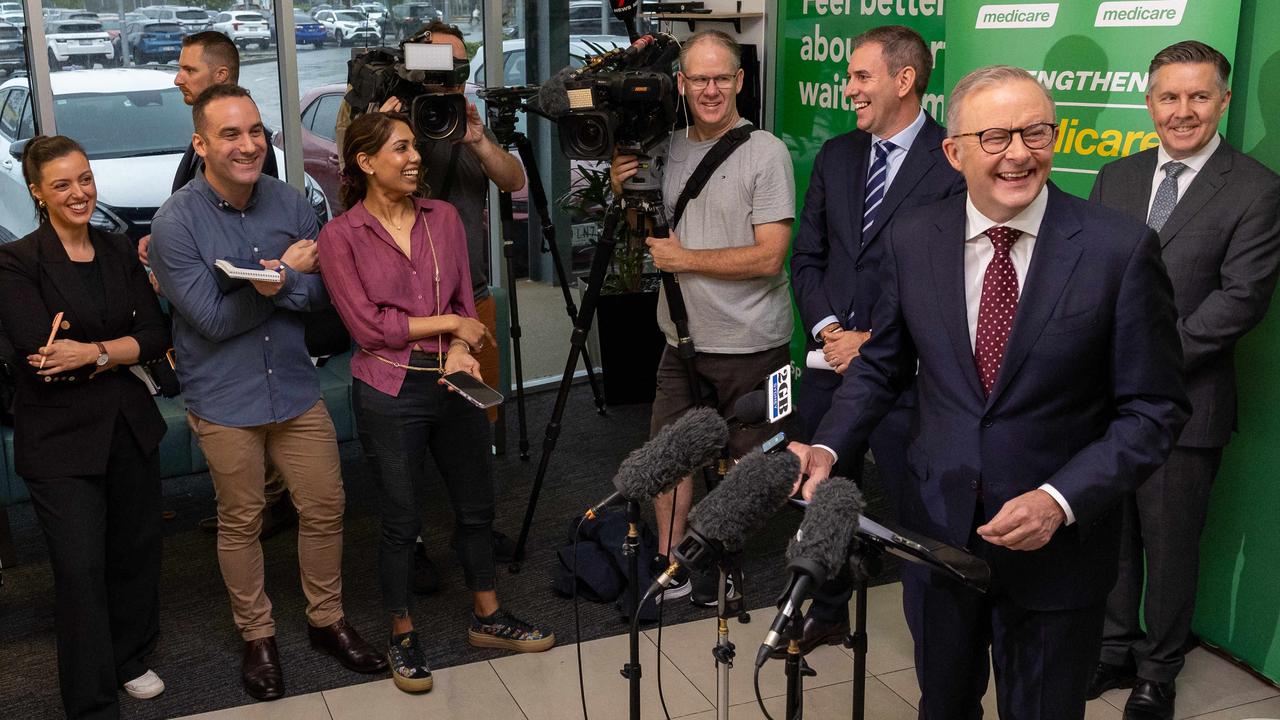
There he is, top right. The man in dire need of an editor. Picture: Jason Edwards/NewsWire
A one-on-one interview can be more valuable, because the candidate has less scope to filibuster, and can’t move on to a different questioner if they’re uncomfortable.
In other words the interviewer actually has a chance to follow up on the politician’s answers, or to press them repeatedly on the same issue.
So look, the above are all essential parts of any election campaign. Yes, even the photo ops. Images are powerful, and there’s no point pretending otherwise. But the most essential, most revealing moments are almost always delivered not by the professional journalists, or people who have been vetted ahead of time by party staff, but by the broader, untameable public.
We typically see the candidates, at least occasionally, strolling through suburban shopping centres and meeting people at random. Maybe they’ll visit an RSL, or a pub, or the Easter Show. Whatever the venue, the point is they’re exposing themselves to folks who might confront them; argue with them; force them to justify themselves.
Maybe they’ll run into a grandmother coming out of Woolies who likes them personally, but disagrees vehemently with their immigration policies.
Maybe they’ll meet a guy who quite simply hates their guts.
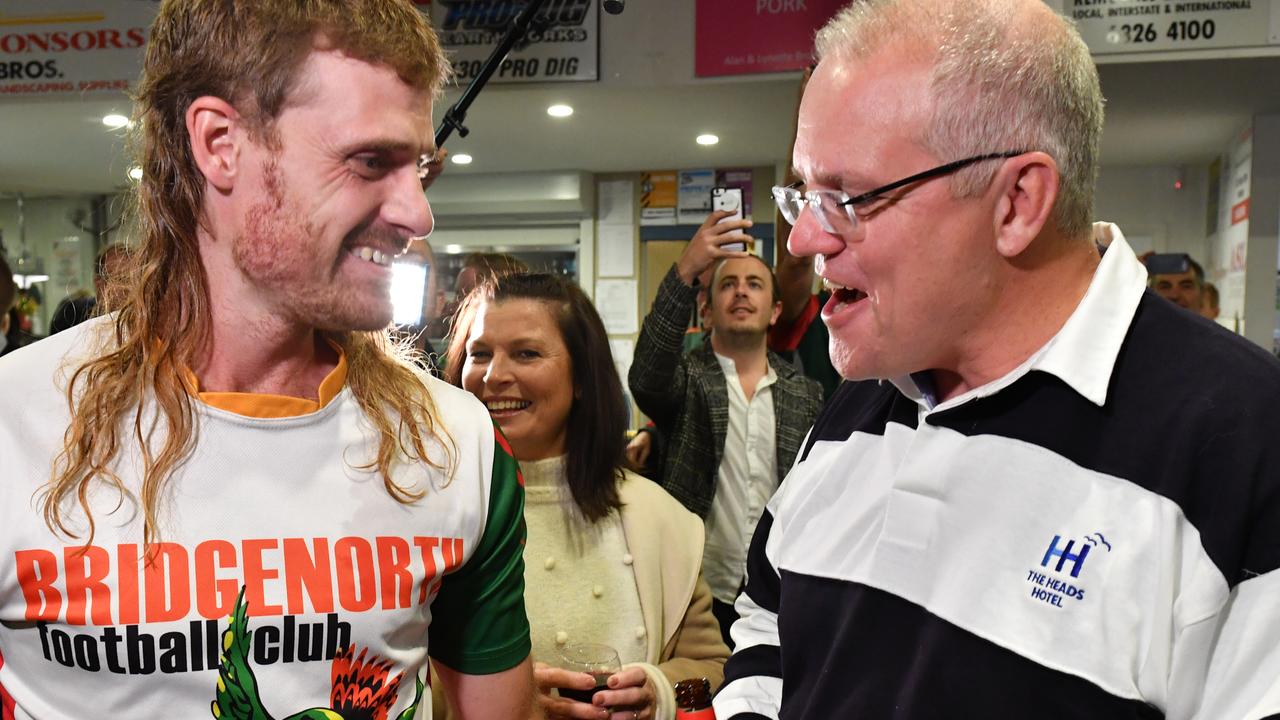
Scott Morrison chatting with a random bloke at a pub in Tasmania back in 2019. Picture: Mick Tsikas/AAP
You can learn quite a bit about any prime minister, as a human being, from the way they handle an angry voter shouting in their face for two minutes, or a calm voter laying out their worries. As much as you’d glean from most 30-minute sit-down interviews.
It doesn’t have to be dramatic. It can be a calm, polite discussion.
The value comes from shaking the politician out of the pantomime interactions they have with journalists and making them speak with a real person, whose concerns they can’t dismiss with a quip, a smirk, or a deluge of unrelated talking points. It’s a different type of conversation.
If I’m at a press conference, and I ask Mr Albanese why he failed to keep his pledge to lower people’s electricity prices by $275, he’ll almost immediately pivot into a laundry list of the government’s cost of living measures, and probably tack on a few pre-rehearsed potshots at the Coalition’s nuclear energy policy.
If Mr Albanese is walking through a shopping centre though, and a voter who can barely afford her rent demands to know why her power bills are so high, he has to engage more directly, and without the political BS.
You’ll have seen a great many politicians, in your time, field a journalist’s question, give an unrelated answer, and brush off the inevitable follow-up with “I’ve answered your question”. You can’t do that to a member of the public. Not without looking like a complete arse.
We’ve had none of those proper public-facing events from the Albanese campaign so far. The closest he’s come: a quick visit to a pharmacy in Melbourne on Thursday, and another to the site of a future healthcare complex in northwest Tasmania on Wednesday, where he met a few of the people who’ll benefit from it.
Even those were very much low risk events.
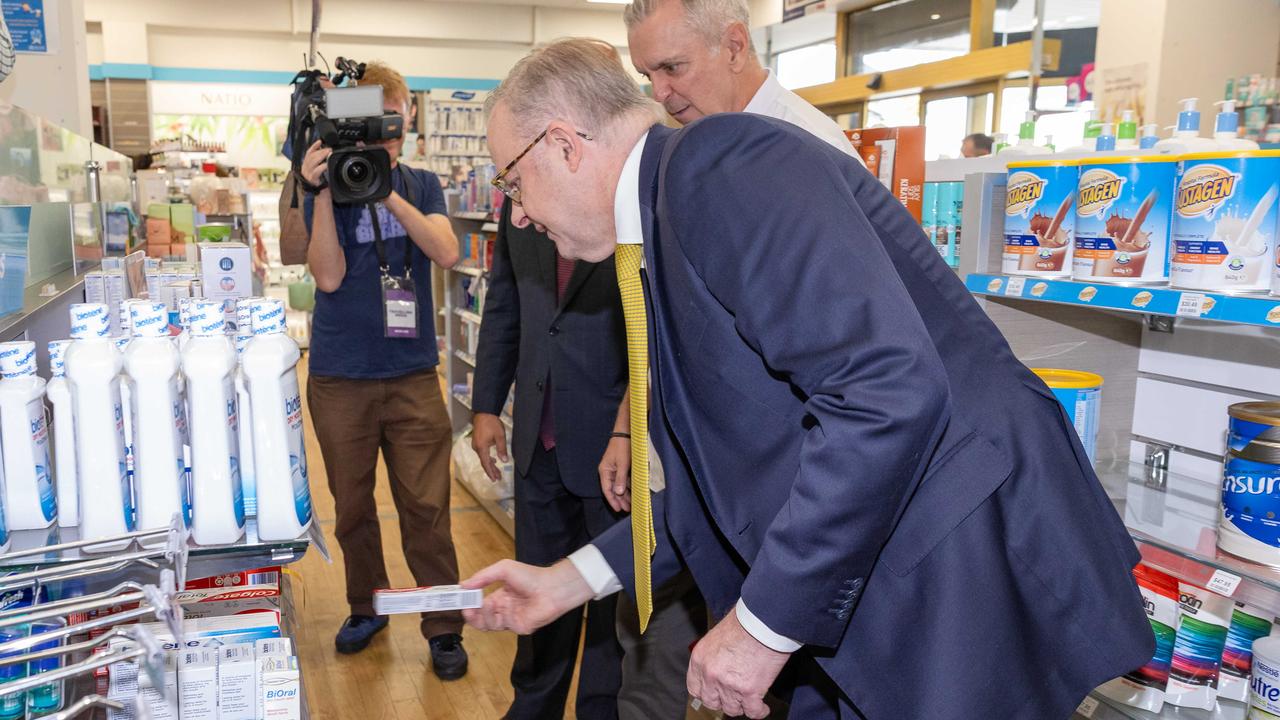
I believe he bought some toothpaste from the pharmacy. Like a normal person! Picture: Jason Edwards/NewsWire
So look, it’s been a quite tightly controlled campaign so far, and you can understand why. Mr Albanese’s team doesn’t want to expose him to much potential hostility, particularly after what happened on the first day of the campaign, when a heckler interrupted his press conference.
But you cannot keep the Prime Minister away from the full spectrum of scrutiny for another month, and nor should you try. Members of the public deserve a chance to grill the guy.
We never talk about the upside of interacting with the public, by the way. Upsides plural, actually. First, the public doesn’t just learn about the politician; it works both ways. Understand the people’s concerns better, and you’re better equipped to address them.
Second, in a purely political sense, there are few things more potent than a genuine interaction. Even if a voter blows up at you, handling it well can win you new respect.
There was a moment in the 2019 campaign that stuck with me. Bill Shorten was holding a press conference outside a hospital in Melbourne. A gentleman in a wheelchair approached the pack and waited, patiently, to ask the then-opposition leader a question.
When the media conference ended, Mr Shorten went straight over to the man, knelt beside him, and listened to his story.
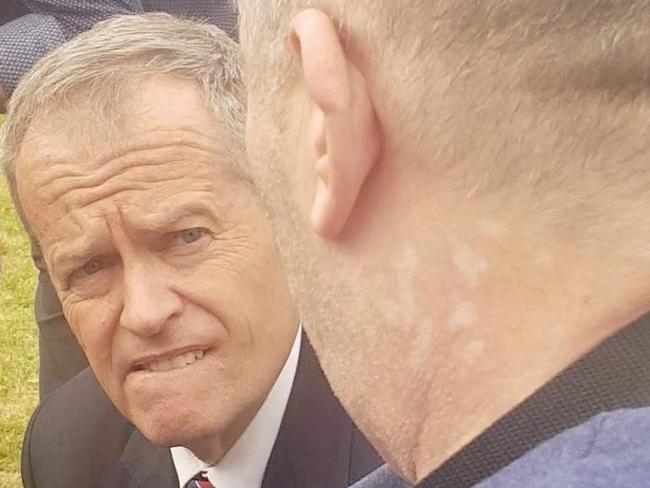
Bill Shorten speaking to Mr Gibbs.
Rob Gibbs, 48, was a former Country Fire Authority volunteer battling chronic myeloid leukaemia, a type of cancer. He told Mr Shorten about his fears for his family – his six-year-old daughter had been asking whether he was going to die in hospital. And he said the state’s Labor premier – at the time that was Dan Andrews – had failed to deliver on a promise to “look after me”.
Mr Shorten listened, and offered what seemed to be genuine sympathy, and said he would try to help Mr Gibbs. He didn’t promise any “outcomes”, and Mr Gibbs didn’t expect him to. The man did not suddenly decide politicians could be trusted after all.
But it was a human moment. The sort of moment that makes day-to-day politics seem silly and pointless (because it often is). The sort of moment that reminds you there’s something beneath the caricatured version of every politician.
The sort of moment that will never, ever happen if a campaign limits itself to carefully controlled events, inaccessible to the general public.
This campaign is missing that so far, and is poorer for it.
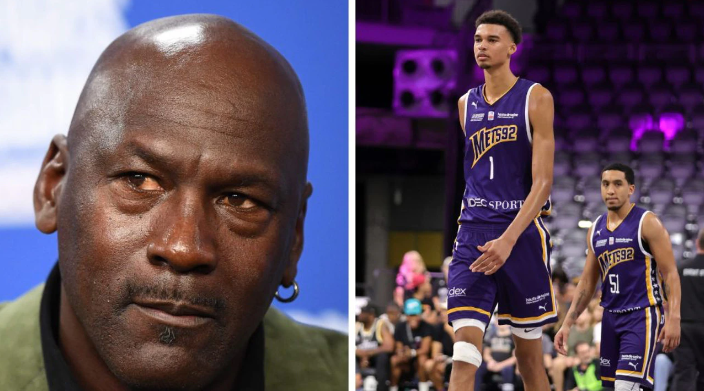

Leave a Reply